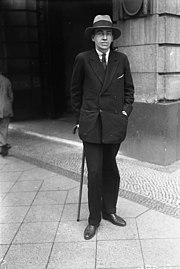Cornelius IV Vanderbilt's Human Design Chart
3/5 Sacral GeneratorAmerican newspaper publisher, journalist, author and military officer from a noted family, the only son of Cornelius “Neily” Vanderbilt III (1873–1942) and his wife Grace Graham Wilson Vanderbilt (1870-1953). He was an outcast of high society who was disinherited by his parents when he became a newspaper publisher. He desired to live a “normal” life but was burdened by large debt and could not maintain the lifestyle associated with his family’s social position.
Throughout his life, he was known as “Cornelius Vanderbilt, Jr.” whereas his father, after 1918, was commonly referred to as “General Vanderbilt”, as he had served as a brigadier general in the First World War. The younger Vanderbilt was commonly called “Neil” by his family and friends.
Shortly after the United State declared war on Germany, much to the chagrin of his mother, Vanderbilt enlisted in the U.S. Army in July 1917 at the age of 19. He was posted overseas with his division in May 1918. In France, he had a temporary assignment as driver to General Douglas Haig, the commander of the British forces in France. He got the posting when he was in a group of soldiers who asked if anyone knew how to drive a Rolls Royce. Vanderbilt raised his hand since his family only used Rolls-Royces and he was familiar with the peculiarities of their operation. Vanderbilt was honorably discharged from the Army on 25 January 1919.
To his parents’ dismay, he became a newspaperman. His parents detested the press, seen by them as an invasion of privacy. He worked as a staff member of the New York Herald and later The New York Times in which he had several articles published. In the early 1920s, Vanderbilt launched several newspapers and tabloids—the Los Angeles Illustrated Daily News, the San Francisco Illustrated Daily Herald and the Miami Tab among them.
In 1929, he released Reno, a novel about divorce set in Reno, Nevada, where he had been living since his first divorce in 1927. In 1934 Vanderbilt made the anti-Nazi documentary exposé, Hitler’s Reign of Terror, regarded as the first anti-Nazi film produced. It particularly highlights the Nazis’ oppression of Jews.
In 1935 Vanderbilt published his autobiography, Farewell to Fifth Avenue. The book provides significant insight to life of those in high society in the early 20th century. He authored other books, including a biography of his mother, Queen of the Golden Age and Personal Experiences of a Cub Reporter.
In 1938, Vanderbilt was commissioned in the United States Army Reserve. As of 1941 he was on active duty with the rank of major in the Intelligence Corps. He was presented with a commendation by the FBI, probably for counterintelligence work, in 1942.
Vanderbilt made his home in Reno, Nevada and continued to write and lecture on world affairs. In 1948 he was a strong supporter of the newly created state of Israel. In 1960, he joined Airtronics International Corporation of Fort Lauderdale, Florida as a vice president and director. In that role, he acted as a liaison executive between Airtronics and its civilian customers.
Cornelius Vanderbilt IV was married seven times and had no children. He died on 7 July 1974, aged 76, in Reno and was buried in the Vanderbilt family mausoleum in the Moravian Cemetery on Staten Island.
Link to Wikipedia biography
Discover More Famous People
Browse and analyze over 55,000 public figures and celebrities.
Ra Uru Hu
5/1 Manifestor
Martha Stewart
4/6 Manifestor
David Lynch
4/6 Generator
Barack Obama
6/2 Projector
Steve Jobs
6/3 Generator
Vladimir Putin
5/1 Manifestor
Kim Kardashian
3/5 Generator
Michael Jackson
1/3 Projector
Marilyn Monroe
6/2 Projector
Ariana Grande
2/4 Projector
Oprah Winfrey
2/4 Generator
Johnny Depp
2/4 ManifestorWhat is HumanDesign.ai and how does it work?
Curious what makes Cornelius IV Vanderbilt tick? HumanDesign.ai instantly maps their exact birth data into a fully interactive clickable bodygraph chart, letting you hover or tap every center, channel, and gate for plain-language explanations. Bella, the platform’s built-in AI guide, adds context in real time, translating complex mechanics into everyday insights so you can see how Cornelius IV Vanderbilt’s strengths, challenges, and life themes play out on-screen.
The same tools are waiting for you. Generate your own Human Design Chart in seconds, open a library of 2000+ suggested questions, and chat with Bella as often as you like to decode your design, daily transits, and even relationship dynamics.
Want to compare energies? Save unlimited charts for friends, family, or clients, then ask Bella to reveal compatibilities, composite patterns, or coaching tips, all in one conversation thread.
Start free with core features, or unlock our Personal and Pro plans for deeper dives: unlimited Q&A, celebrity chart search spanning 55,000+ public figures, white-label PDF reports, branded content generation, and a professional profile with built-in booking for practitioners. Whether you’re exploring your own potential or guiding others, HumanDesign.ai delivers an ever-expanding toolbox of AI-powered insights—no spreadsheets, no jargon, just clarity at your fingertips.
Ready to see yours? Signup for FREE today!

